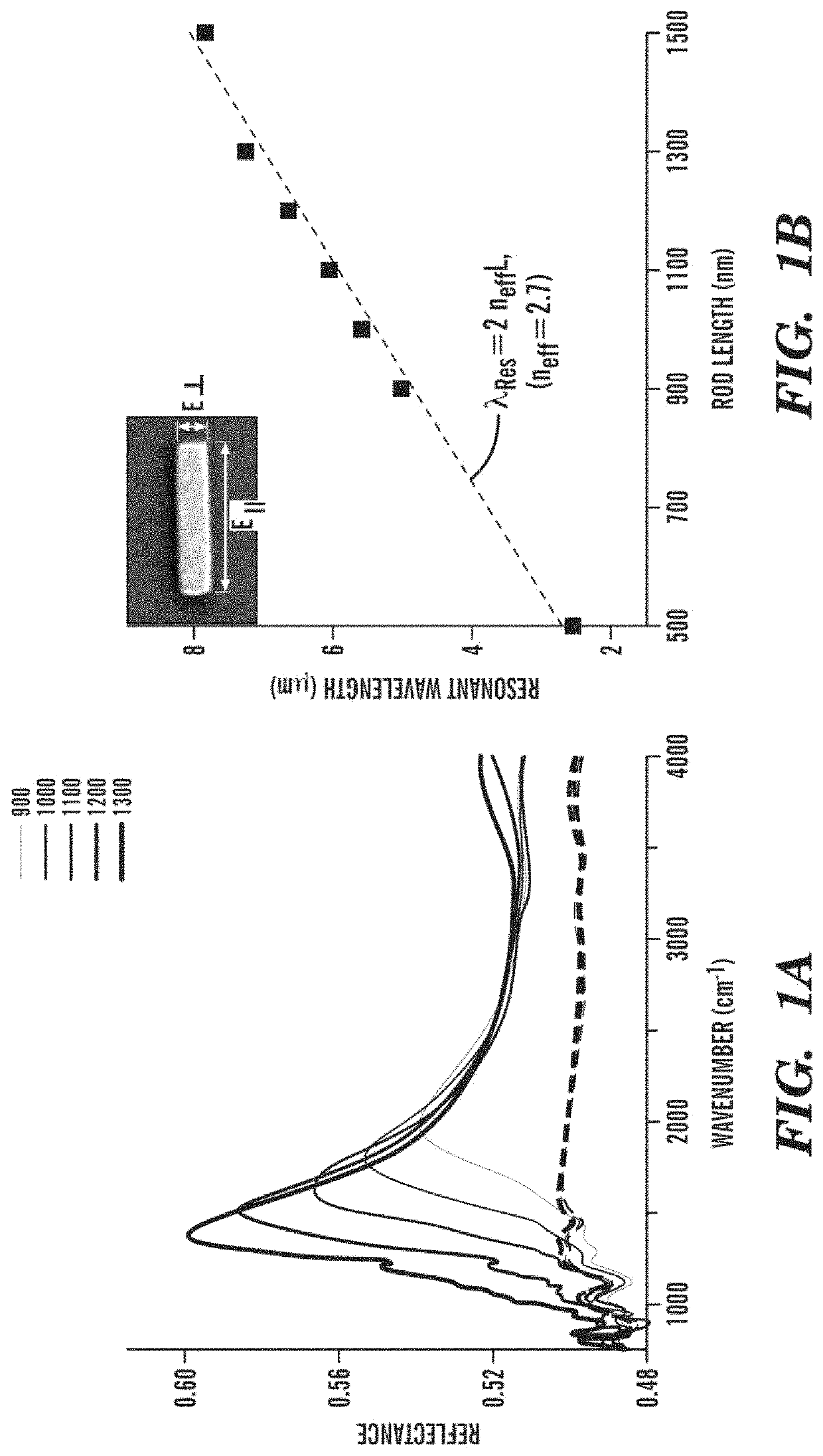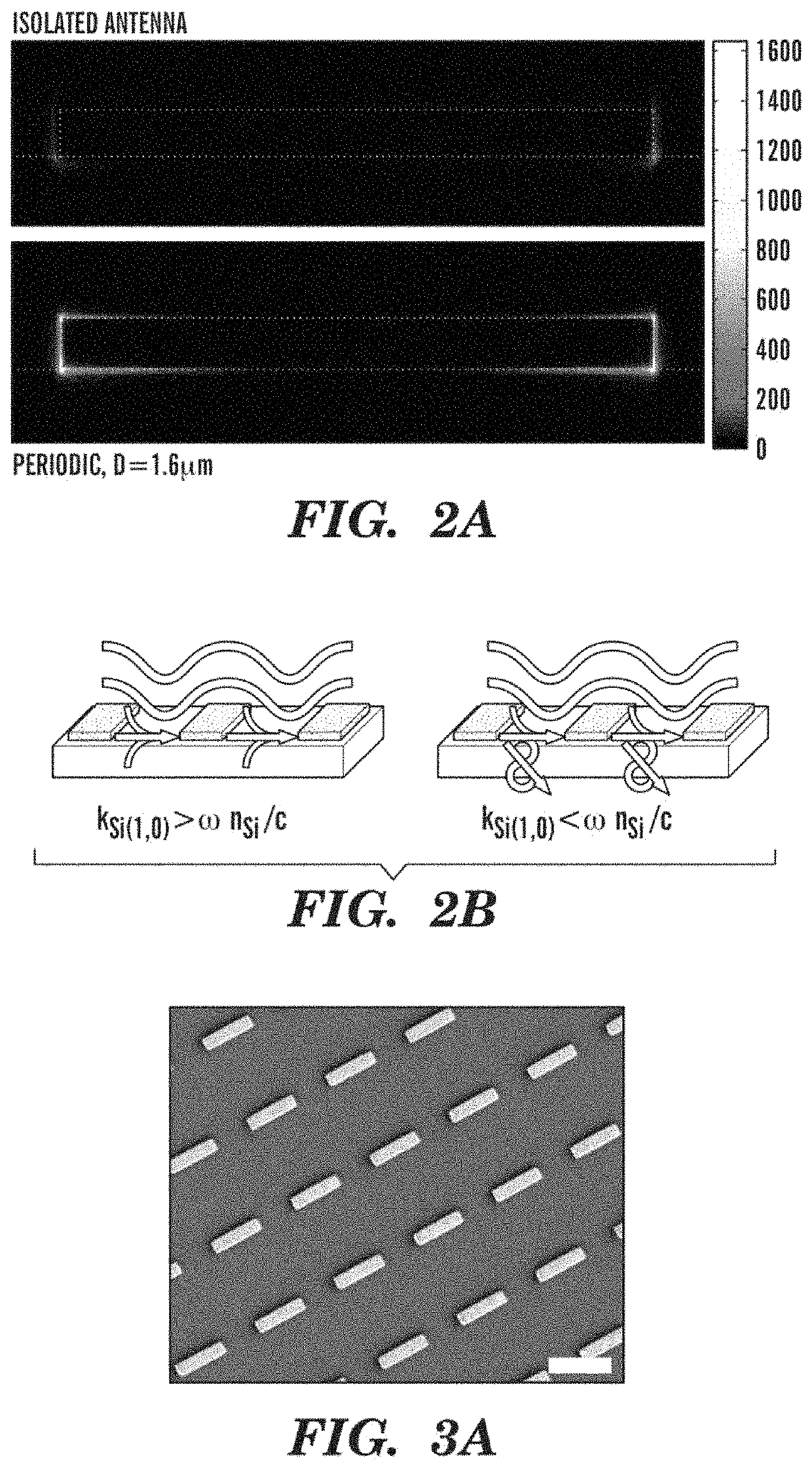Nanoantenna arrays for nanospectroscopy, methods of use and methods of high-throughput nanofabrication
a nanoantenna array and nanotechnology, applied in the field of nanoantenna arrays, can solve the problems of weak absorption signals, limited signal enhancement factors, poor spectral overlap between plasmonic resonance and molecular vibrational modes of interest, etc., and achieves enhanced ir absorption (ceira), high reliability and reproducibility, and long plasmon lifetimes.
- Summary
- Abstract
- Description
- Claims
- Application Information
AI Technical Summary
Benefits of technology
Problems solved by technology
Method used
Image
Examples
example 1
Nanoantenna Arrays
As disclosed herein, the inventors demonstrate that the engineered nanoantenna arrays can support spectrally well-defined resonances with strong local fields. Furthermore, plasmonic resonances in these nanoantenna arrays can be fine-tuned to specific spectral regions of interest with high spatial reproducibility. Recently, enhanced absorption signals have been observed from individual nanoantennas (Jensen et al., (2000); Applied Spectroscopy 54:371-377., Kundu et al., (2008) Chemical Physics Letters. 452:115-119; Neubrech et al., (2008) Physical Review Letters 101:157403; Bukasov et al., (2009). Analytical Chemistry 81:4531-4535). However, a surprising new phenomena arises as a result of the collective resonant excitation of the spatially and geometrically organized nanoantenna in specific pattern ensembles. In the nanoantenna arrays as disclosed herein, where the nanoantenna (or plasmonic nanostructures) are organized in a predefined pattern on the nanoantenna arr...
example 2
Individual and Collective Resonances of Plasmonic Nanoantennas
The plasmonic nanoantenna arrays for enhanced collective response were engineered herein based on the individual antenna behavior. To obtain individual response with a good signal to noise ratio using a conventional Fourier-transform infrared (FTIR) microscope, the nanoantennas were randomly positioned on the support of the array. As previously demonstrated by the inventors, the random arrangement of the nanoantenna array cancels out any diffractive behavior (Yanik et al., (2008) Appl. Phys. Lett. 93:081104). As shown in FIG. 9, the spectral measurements are independent from the randomization process and clearly reflect the individual antenna response. FIG. 1A demonstrates the infrared reflectance measurements from randomized arrays consisting of varying length and a fixed width (230 nm) of nanorods pointing in the same direction on an area of 100×100 μm2. The structures are fabricated on silicon supports using electron b...
example 3
SEIRA Enhancement by Collective Resonances
Direct identification of the vibrational signatures of the protein monolayers is achieved by utilizing this collective excitations. Here, the protein layer is applied to the nanoantenna array surface by uniform spin coating of a thin film of silk fibroin (as described in the material and methods section herein). As mentioned before, a unique advantage of silk is that it allows fine control over the protein film thickness by varying its concentration in solution (Omenetto et al., (2008), Nature Photonics. 2:641-643). Homogeneous films were coated on the nanorod antenna array as thin as 2 nm, corresponding to essentially a single protein monolayer. Atomic force microscopy (AFM) is used to confirm the uniformity and the thickness of the film. Initially, the scanning of the tip is performed in contact mode to scratch away the film down to the silicon support. Subsequent measurements at reduced force are then used to determine the film thickness ...
PUM
| Property | Measurement | Unit |
|---|---|---|
| height | aaaaa | aaaaa |
| height | aaaaa | aaaaa |
| height | aaaaa | aaaaa |
Abstract
Description
Claims
Application Information
 Login to View More
Login to View More - R&D
- Intellectual Property
- Life Sciences
- Materials
- Tech Scout
- Unparalleled Data Quality
- Higher Quality Content
- 60% Fewer Hallucinations
Browse by: Latest US Patents, China's latest patents, Technical Efficacy Thesaurus, Application Domain, Technology Topic, Popular Technical Reports.
© 2025 PatSnap. All rights reserved.Legal|Privacy policy|Modern Slavery Act Transparency Statement|Sitemap|About US| Contact US: help@patsnap.com



